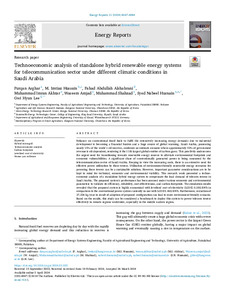| dc.date.accessioned | 2024-04-26T08:19:45Z | |
| dc.date.available | 2024-04-26T08:19:45Z | |
| dc.date.issued | 2024-04-05 | |
| dc.identifier | doi:10.17170/kobra-2024042610089 | |
| dc.identifier.uri | http://hdl.handle.net/123456789/15714 | |
| dc.description.sponsorship | Gefördert durch den Publikationsfonds der Universität Kassel | |
| dc.language.iso | eng | |
| dc.rights | Attribution-NonCommercial-NoDerivatives 4.0 International | * |
| dc.rights.uri | http://creativecommons.org/licenses/by-nc-nd/4.0/ | * |
| dc.subject | Hybrid microgrid | eng |
| dc.subject | Techno-economic analysis | eng |
| dc.subject | Carbon footprints | eng |
| dc.subject | Levelized cost of electricity | eng |
| dc.subject | Homer pro software | eng |
| dc.subject.ddc | 333 | |
| dc.title | Technoeconomic analysis of standalone hybrid renewable energy systems for telecommunication sector under different climatic conditions in Saudi Arabia | eng |
| dc.type | Aufsatz | |
| dcterms.abstract | Reliance on conventional fossil fuels to fulfil the extensively increasing energy demands due to industrial development is becoming a financial burden and a huge source of global warming. Saudi Arabia, possessing nearly 15% of the world's oil reserves, confronts an intricate scenario where approximately 53% of government revenue is oil-dependent, rendering it the 11th largest global emitter of carbon gases. This proclivity underscores the urgent need for transitioning towards renewable energy sources to alleviate environmental footprints and economic vulnerabilities. A significant share of conventionally generated power is being consumed by the telecommunication sector of Saudi Arabia. Keeping in view the increasing costs, there is an extensive need for effective power utilization by these towers. Utilization of environment-friendly renewable energy resources for powering these towers can be a sustainable solution. However, important parameter considerations are to be kept in mind for technical, economic and environmental viability. This research work presented a techno-economic analysis of a standalone hybrid energy system to compensate the load demand of telecom towers in Saudi Arabia. The proposed system's performance has been assessed under various economic and environmental parameters to validate its efficiency, reliability, cost-effectiveness, and carbon footprints. The simulation results revealed that the proposed system is highly economical with levelized cost of electricity (LCOE) 0.18$/kWh in comparison to the conventional power system currently in-use with LCOE 0.46$/kWh. Furthermore, reduction of 37,326 kg/year in result of adoption of proposed configuration can lead to more environment friendly scenario. Based on the results, this study can be considered a benchmark to deploy this system to power telecom towers effectively in remote regions worldwide, especially in the middle eastern region. | eng |
| dcterms.accessRights | open access | |
| dcterms.creator | Husnain, Syed Nabeel | |
| dcterms.creator | Asghar, Furqan | |
| dcterms.creator | Hussain, Muhammad Imtiaz | |
| dcterms.creator | Alshahrani, Fahad Abdullah | |
| dcterms.creator | Akhtar, Muhammad Imran | |
| dcterms.creator | Amjad, Waseem | |
| dcterms.creator | Shahzad, Muhammad | |
| dcterms.creator | Lee, Gwi Hyun | |
| dc.relation.doi | doi:10.1016/j.egyr.2024.03.055 | |
| dc.subject.swd | Saudi-Arabien | ger |
| dc.subject.swd | CO2-Bilanz | ger |
| dc.subject.swd | Elektrizitätskosten | ger |
| dc.subject.swd | Hybride Energie | ger |
| dc.subject.swd | Telekommunikationswirtschaft | ger |
| dc.type.version | publishedVersion | |
| dcterms.source.identifier | eissn:2352-4847 | |
| dcterms.source.journal | Energy Reports | eng |
| dcterms.source.pageinfo | 4067-4084 | |
| dcterms.source.volume | Volume 11 | |
| kup.iskup | false | |


